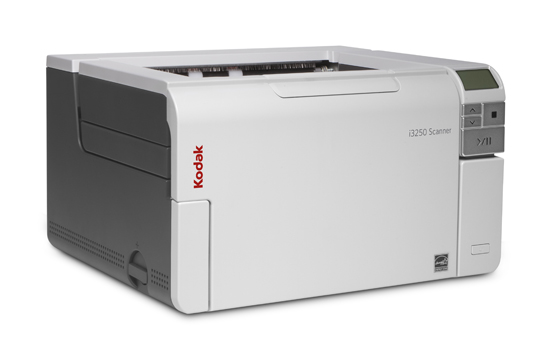It’s no shrinking violet, though. Its 432 x 371 mm footprint will consume a sizeable part of any desk, while its 18 kg mass means that it’ll need a good set of legs to rest on too. The size, though, is large only in comparison with typical desktop models. Placed next to industrial scanners, it cuts a rather more compact figure. Its recommended daily volume has been pushed up to 15,000 pages per day for the sheetfed – half as much again as that of the i2900 – making this a model that should cope with very high workloads. Assuming you have room for the i3250, you’re unlikely to find it wanting. Like its predecessor, it’s comes with a choice of feeds. Bundles of documents will be swallowed up by the 250-sheet feeder. We found this to be mostly reliable, although a batch of Vanity Fair articles, complete with jagged edges, did cause a few mishaps. Most other document types, though, slipped through without a glitch.
Kodak i3250 review: Performance
The interface works best with USB 3.0. The speed of this machine is astounding, and a 50-page document went through in just 29 seconds at 200 dpi. With OCR on, it was converted into a fully searchable PDF within a further 10 seconds. Without OCR, the extra time required slipped to just 6 seconds. That amounts to a stunning 85.7 pages per minute. And around 4 seconds of that time arose from the i3250 dropping everything into place, so larger bundles would complete at an even greater rate. Higher output rates are available, and 300 and 600 dpi scans were completed within 41 and 102 seconds respectively. The model handles A3 just as comfortably as A4, requiring only a second for each sheet of the larger paper size. As with the i2900, the i3250 has another scanning option up its sleeve, in the A4 flatbed component. This can obviously only scan single sheets at a time, but it means that you don’t have to entrust your precious documents to a potentially harmful sheetfed. Since the pages on a flatbed aren’t sucked into the machine, there’s no risk of damage. This feature also benefits from a brilliant book-edge feature, which sees the scanning glass run right up to the edge of the Kodak. If you want to scan a book, you no longer have to cram the entire volume underneath the scanning lid. Instead, you can let half of the book hang down at a 90 degree angle. The other half will be tightly gripped and held flat within the flatbed component. So you won’t see the spine, and every letter of every sentence will be properly rendered. As a way of successfully scanning books without damaging them or putting up with substandard results, this is quite brilliant. It also works better than the bookedge feature on lesser models, as the flatbed component is situated towards the middle of the machine. That ensures you have plenty of weight bearing down, so you don’t have to hold down the lid in order to stop the books from popping back up. Quality is, as you would expect from a scanner in this price range, supreme. Text is boldly defined, even at lower resolutions, while the palette is rendered with immaculate attention to detail. It can jump from text to pictures to intricate charts and codes without dropping a notch. We have yet to review a more accurate device, and the Kodak i3250 combines pace and accuracy in one stunning package. The software drivers are easy to use, and the OCR worked very well. Having said that, Kodak fully expects that, if you’re spending this much on a scanner, you’ll almost certainly be using professional third-party software to create the very best results. So while you can scan in high-quality mode out of the box, you shouldn’t expect the raft of software titles that you might get with a model lacking a four-digit price tag. The drivers are relatively powerful, though, allowing you to manipulate most aspects of the image, automatically flipping images or tweaking the colour.
